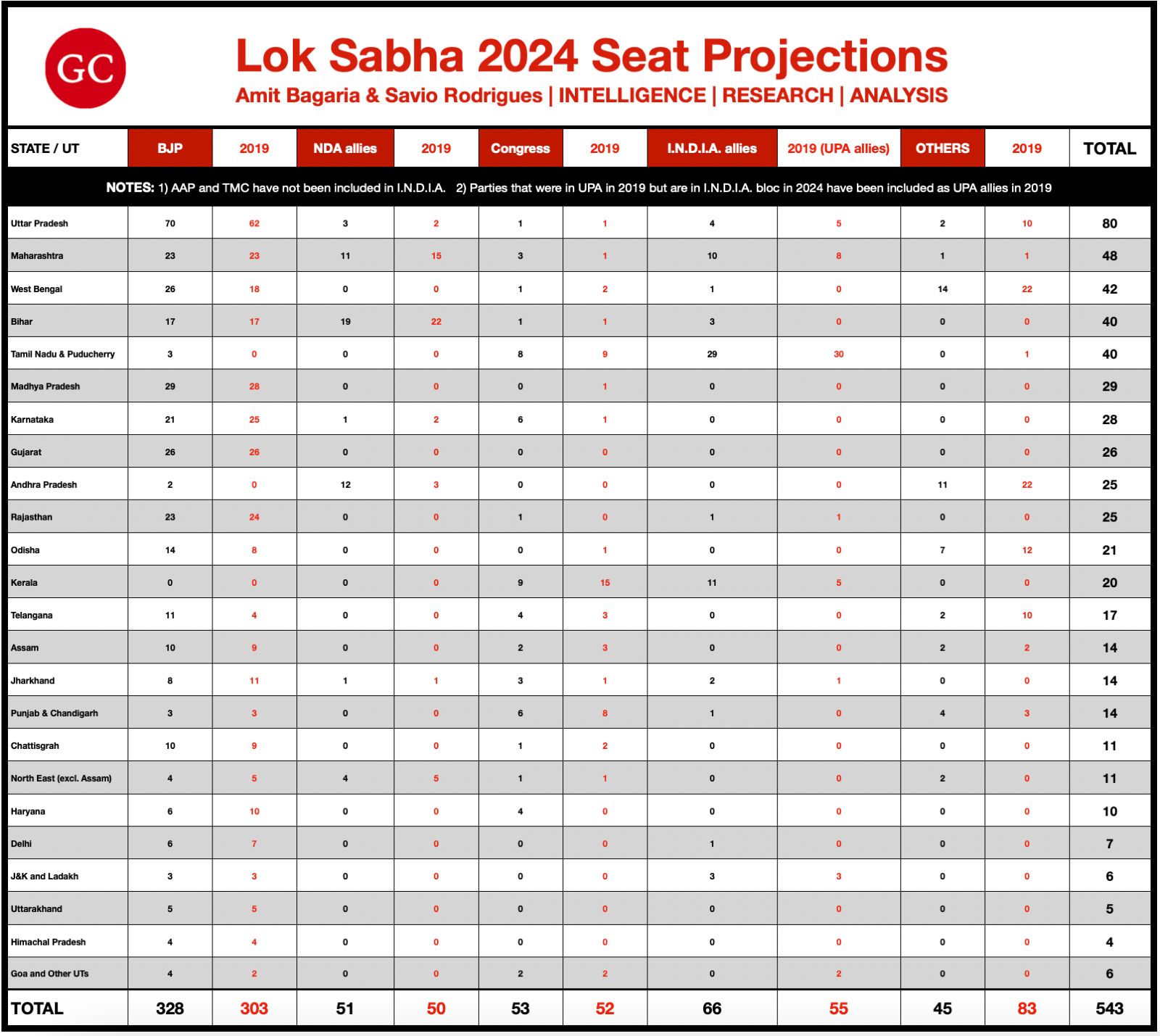Approximately 970 million people out of a total population of 1.4 billion people were eligible to vote in India’s longest (44 days) general elections to elect the country 18th Lok Sabha (Lower House of Parliament), but unfortunately, a shade below two-thirds actually voted, based on data for the first six out of total seven phases.
The shining light of voter turnout was a 58.58% turnout in Jammu and Kashmir, compared with just 35.2% in 2004, 39.7% in 2009, 49.52% in 2014, and 44.97% in 2014.
Before I come to the projections, I have to say that anything more than a 24-day election cycle is just not acceptable, and the Election Commission can easily have five phases instead of seven, with voting every five days, and the results declared by the 28th day.
Given below are the state/UT-wise projections for the two major parties (BJP and Congress) and the two major alliances, the National Democratic Alliance (NDA) and the Indian National Developmental Inclusive Alliance (I.N.D.I.A.), based on the on-the-ground reports that Savio (Editor-in-Chief of Goa Chronicle) and I have been regularly receiving from hundreds of journalists, pollsters, surveyors, and activists of the major political parties from the time that the first phase of voting began.

Overall, the BJP is expected to gain 25 seats, an increase of 8.3% from the 303 seats that the ruling party won in 2019. BJP’s biggest gains in terms of percentage of seats are expected from Telangana (175%), followed by Odisha (75%), West Bengal (44.4%), and Uttar Pradesh (12.9%); while its biggest loss is expected to be in Haryana (-40%), followed by Jharkhand (-27.3%), Karnataka (-16%), and Delhi (-14.3%).
The Indian National Congress (Congress) is expected to gain just one seat, an increase of just 1.9% from the 52 seats that the main opposition party won in 2019. Congress’s biggest gains in terms of percentage of seats are expected from Karnataka (500%), followed by Jharkhand and Maharashtra (200% each), and Telangana (33.3%); while its biggest loss is expected to be in Madhya Pradesh and Odisha (-100% each), followed by West Bengal (-50%), Kerala (-40%), and Assam (-33.3%).
Coming to the regional parties (some of which live in a delusional world believing that they are national parties as their leaders dream of becoming the Prime Minister or PM of India), the biggest loser is expected to be KC Rao’s Bharat Rashtra Samithi (BRS) of Telangana (-88.9%), followed by Mayawati’s Bahujan Samaj Party (BSP) of Uttar Pradesh (-80%), YS Jagan Mohan Reddy’s Yuvajana Sramika Rythu Congress Party (YSRCP) of Andhra Pradesh (-50%), Naveen Patnaik’s Biju Janata Dal (BJD) of Odisha (-41.7%), and Mamata Banerjee’s “All India” Trinamool Congress (TMC) of West Bengal (-36.4%).
While BRS, YSRCP, and TMC will bounce back, it is the end of the road for BSP and BJD. Having said that, if the BJP does end up winning 26 seats (as projected by us) in West Bengal, or almost double of Mamata’s projected 14 seats, the BJP will pose a strong challenge to Mamata in the April 2026 state assembly elections and may even end up dethroning her from the CM ‘throne’ that she has enjoyed and juiced for 15 years.
The only regional party to gain in these elections will be Arvind Kejriwal’s Aam Aadmi Party (AAP), which we project will increase its tally from one seat to three seats in Punjab.
AAP is recognised by the Election Commission as a ‘national’ party as it won more than 6% votes in four state assemblies. This is a mockery of India’s electorate. Any party with less than 54 seats in the Lok Sabha (10% of the seats) should not get ‘national’ status.
If the actual results on counting day (Tuesday, 4th June) are more or less in line with our projections, then the biggest takeaway from these elections will be that the Indian electorate is getting smarter every five years. Instead of voting for tall promises of freebies or on the basis of caste, Indian voters are now voting for development, nationalism, and actual performance.
On 4th June, Narendra Modi will become the 2nd prime minister in history to win a 3rd term in office. He will be the first to do so since Jawaharlal Nehru in 1962. In May 2019, Modi had become the 4th PM to get elected for a 2nd full-term of five years, and only the 3rd to get a majority. With 354 seats for the NDA, he was just eight seats short of a two-thirds majority. This was also the 1st time when the Congress party did not come back to power after a full 5-year term of non-Congress rule.
On Independence Day (15th August) 2020, Modi became the longest-serving non-Congress PM, surpassing the 2272 days of the first and only other BJP PM, Atal Bihari Vajpayee. Yesterday (31st May 2024), Narendra Modi crossed Dr Manmohan Singh’s term (10 years and 4 days) to become India’s 3rd longest serving prime minister, after Jawaharlal Nehru (16 years and 286 days) and Indira Gandhi (15 years and 350 days). When he is sworn in on 10th June (as is expected by many), he would be PM for 10 years and 15 days.
To beat Indira Gandhi’s tenure, Modi will have to win a 4th term in 1929 and remain PM till at least 12th May 2030. Having enforced a self-imposed policy of retirement at the age of 75 for all his ministers since 2014, will Modi accept being PM till he is over 79.5 years of age? Only time will tell, and I shall certainly wait till 2029.
The 370 and 400 paar Question: As many people are bound to ask why the BJP will not be able to cross 370 seats on its own, or why the NDA did not cross 400 (the BJP/NDA’s slogan of ‘ab ki baar, chaar sau paar’), please allow me to elaborate.
The number 370 was not meant to be a serious projection, but Prime Minister Narendra Modi only used it to emotionally connect voters with the historical abrogation (revocation) of Article 370 from Jammu and Kashmir, as the PM has said himself in 2-3 recent TV interviews. Therefore, I will ignore the 370 number.
What about 400 paar? This was a more serious projection, or at least a seat target that Modi himself had set for the NDA. If our projections are 100% correct, the NDA will miss this target by 21 seats. While this is almost within the normally accepted ± margin of error, we still need to examine where the NDA could have got these 29 or more seats from.
BJP’s allies, the Shiv Sena (Eknath Shinde faction) and NCP (Ajit Pawar faction) could have easily won 3-4 more seats in Maharashtra had the voters not been so confused with the other Shiv Sena and NCP factions having the same name (in the future, the Election Commission should ensure that, in the case of parties that have split, the smaller party has to change its name). Nitish Kumar’s JDU could have won two more seats in Bihar, the BJP itself could have won at least three more seats in Karnataka if there was one single state leader and if the party did not allow a revolt from many leaders that it denied tickets to. Finally, the BJP should have been able to retain all 10 seats in Haryana and all seven in Delhi.
All these put together would have given the NDA 13-15 more seats, coming to a total of 392-393 seats, or as close to 400 paar as is realistic.
Adieus amigos, until next time!
































